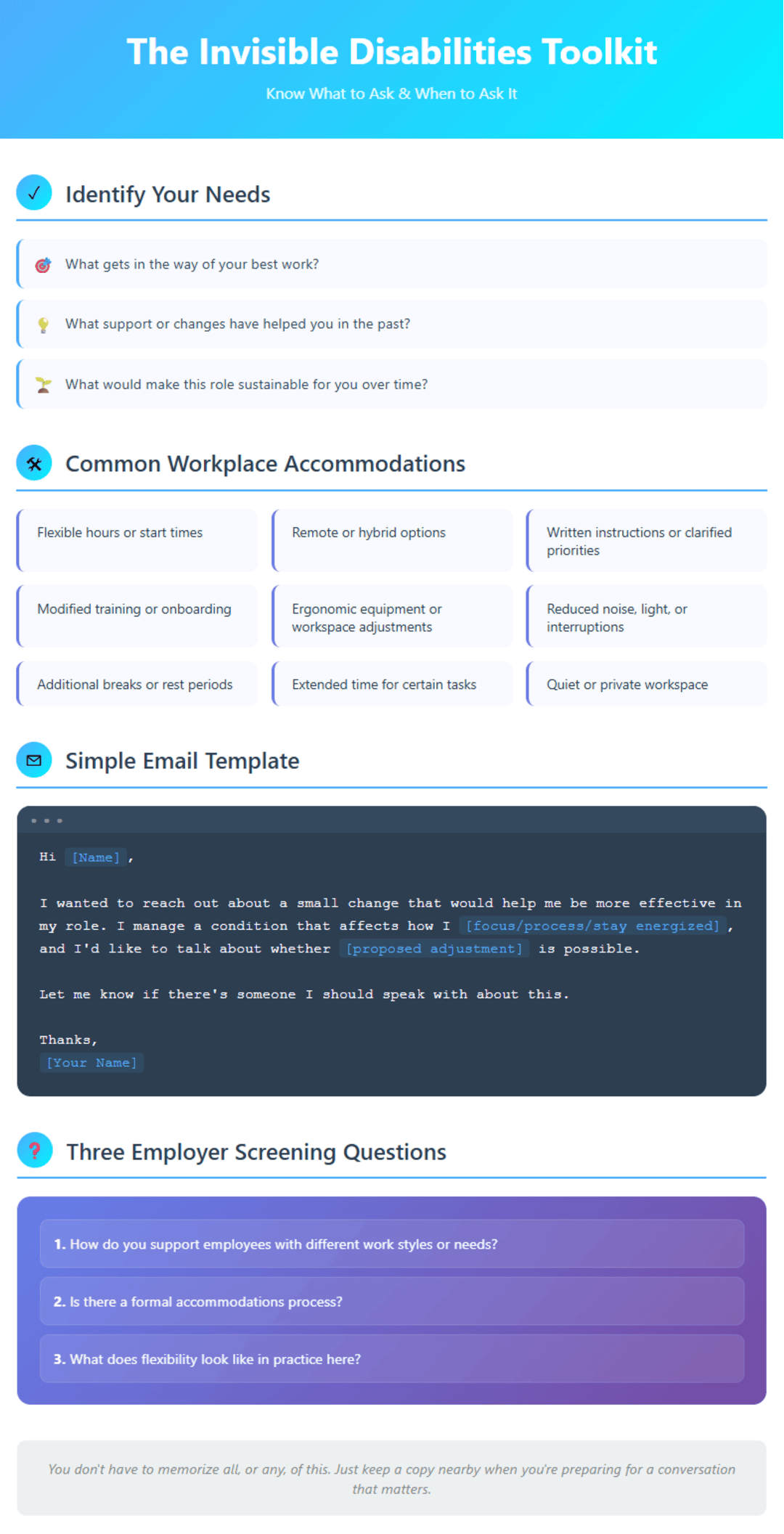You shouldn’t have to struggle with invisible disabilities in silence. You’re qualified. You’re capable. Maybe it’s a chronic illness that suddenly flares up on you. Or, you’re coping with something that others won’t see like, ADHD, anxiety, or any other neurological condition. These are invisible disabilities. Even though they are “invisible,” they are still very, very real. The can make some of the most basic tasks feel like too much.
The Americans with Disabilities Act, covers protections for workers with many different abilities and conditions. But even with this law, just knowing you’re protected isn’t the same thing as knowing: 1. What to ask for. 2. When to ask for it. or 3. How to even do it, at all.
This guide is here to change that, step by step. Because getting support at work shouldn’t require a second full-time job. You’ll learn:
- What counts as an invisible disability (even if it’s not diagnosed)
- What kinds of accommodations you can request, without oversharing
- When to bring it up (and how to protect your privacy)
- Scripts, checklists, and questions to help you speak up with clarity and confidence
Let’s jump right into it.
What Counts as an Invisible Disability?
So, we’re talking about invisible disabilities, and not all of them need a formal diagnosis to qualify for support in the workplace.
Conditions like ADHD, autism, anxiety, PTSD, dyslexia, diabetes, epilepsy, and chronic pain all fall in the realm of “invisible disabilities.” Some can significantly affect your energy or focus. Others can change how you process information, manage stress, or even just move through the day.
Under the ADA, most employees qualify for accommodations when your condition “substantially limits one or more major life activities.” That could be anything affecting standing, thinking, concentrating, remembering, managing stress, or simply making it through a workday.
And yes, even if your symptoms come and go, or are managed by medication, you are still covered under EEO Employment.
One HR advocate says:
“You don’t have to share your diagnosis. You simply have to tell them what will help you do your best work.”
That is your starting point: Not proving you’re disabled, just describing what accommodation you need to succeed.
What Accommodations Can You Request?
Accommodations aren’t “special treatment.” They’re tools, adjustments, or flexibility that help you do your job effectively, without burning out or masking symptoms all day.
And they can be surprisingly simple. Some common examples include:
- ADHD or Anxiety: Things like noise-canceling headphones, written instructions, flexible deadlines, or even extra time to complete tasks.
- Chronic Illness or Fatigue: Remote/hybrid work options, later start/end times, more breaks, or ergonomic seating.
- Neurological Conditions (like Autism or Epilepsy): Try spaces with reduced lighting, consistent & predictable routines, maybe a non-fluorescent workspace, and/or a modified onboarding process.
You don’t have to come in with a whole Cheesecake-Factory-Menu of requests. Start by naming the barrier (what’s hard) and then offer a reasonable adjustment that would help.
Under the ADA, employers are expected to provide accommodations unless it creates “undue hardship” (like high cost or major disruption). Still, most don’t. Think of it like this… If a small tweak can really help you thrive, it’s probably worth asking about it.
When and How to Ask for Accommodations
There’s no one “right” or “obvious” moment to bring up accommodations. You get to choose the when and how to ask for what you need. Here are your main options:
Before You’re Hired
You can mention your needs during the interview process, especially if accommodations would help you interview more comfortably.
Example: “I do best with questions in writing ahead of time. Would that be possible?”
Pro: This builds transparency early, which can equate to trust later
Con: Some candidates prefer to wait until they have some actual leverage, like an offer already on the table
After You Get the Offer
This is also a great time to bring it up, you’ve got the offer in hand, and the company is already motivated to make it work.
Example: “To be most successful in this role, I’d benefit from a flexible start time and written task summaries.”
After You Start (or If Things Change Later)
Maybe symptoms are getting worse. Perhaps you really didn’t need anything at first, but now you really do. That’s normal, and your right to ask doesn’t expire after any amount of time.
You can go start the process with HR, a designated accommodations contact, or your manager, depending on what feels safest.
And no, you don’t have to share your diagnosis. You can say:
“I have a condition that affects how I [focus/process information/experience fatigue], and I’d like to talk about a few ways to make my work setup more efficient and effective.”
Name the challenge + suggest a workable solution. You don’t need to overexplain or give apologies.
Questions to Ask the Employer
No personal information is needed to get a good read on how a company supports people with invisible disabilities. Asking the right questions can tell you a lot about a company’s work culture, without you saying a word about your needs, diagnosis, or condition.
Try asking one or two of these questions during interviews:
“How does your team support different working styles or communication preferences?”
This opens the door to discussions about neurodiversity, remote options, or flexibility, without directly referencing disability.
“Is there a formal process for requesting accommodations or flexible arrangements?”
A clear answer here shows that the company has a plan. If they say “we just figure it out case by case,” that might mean there’s no structure in place.
“Can you share an example of how someone on your team has grown in a way that wasn’t linear or traditional?”
This question helps surface whether they value different strengths or expect everyone to perform the same way.
“What kind of support does your company offer during onboarding or after someone’s been here a few months?”
You’re looking for signs of check-ins, mentorship, or mental health resources, not just a training manual and a calendar invite. If the answers feel vague, uncomfortable, or overly rehearsed, that’s good to know too.
Sample Email Scripts for Requesting Accommodations
There is no “perfect script,” just clear and respectful ones that get the conversation going. These next samples are designed for that; to keep things low-pressure while still getting your needs on-the-record.
Requesting during the interview process:
Subject: Interview Support Request
Hi [Name],
I’m looking forward to our upcoming interview for the [Role] position. I wanted to ask if it’s possible to receive the questions in advance or to do the interview in a quiet space, as I have a condition that affects how I focus under pressure. This would help me show up at my best.
Thanks so much for considering,
[Your Name]
Requesting after receiving an offer:
Subject: Request for Accommodations
Hi [Name],
Thank you again for the offer. I’m excited about the opportunity and wanted to mention a couple of small accommodations that would support my success in this role. I manage a condition that affects my energy levels and having a slightly later start time and written weekly priorities would make a big difference.
Let me know if we can discuss further.
Best,
[Your Name]
Requesting after starting the job:
Subject: Accommodations Discussion
Hi [Name],
I wanted to check in about a work support I could use moving forward. I’ve been managing a condition that affects how I process tasks and avoid burnout, and I’d like to talk about whether a few adjustments, like written task lists or more predictable deadlines, might be possible.
Please let me know a good time to connect.
Thanks,
[Your Name]
These are decent starting points, but you can be as detailed, or as general, as you feel comfortable with. The only point is to just get the conversation started.
Red Flags and Green Lights
You can’t always tell how inclusive a workplace is from one conversation… but you can spot some patterns early. Here’s what to listen up for during interviews, onboarding, or even conversations with human resources.
Red flags to take seriously:
- The company says it handles things “case by case,” but can’t explain how.
- You hear discomfort or surprise when you mention flexibility or accommodations.
- No one seems to know who handles accessibility or workplace support.
- You’re told to “just let your manager know” without a clear process.
- They say, “We expect everyone to rise to the same standard,” without making room for different working styles.
Green lights to look for:
- They can explain their accommodations process clearly and without hesitation.
- You’re told about support options even if you didn’t ask.
- Managers are trained in inclusive practices or mental health awareness.
- Flexible work styles are common and not treated as exceptions.
- They give examples of how employees shape their work environments to suit their needs.
Everyone, especially you, deserves a job that sees them fully and clearly, and takes their needs seriously.

FAQs
Do I have to disclose my diagnosis to get support?
No. Under the ADA, you’re not required to specifically name a diagnosis. You can simply describe the challenge and suggest a reasonable solution. For example: “I have a condition that affects how I process information, and I’d benefit much more from a written task lists.”
What if my request is denied?
Employers are required to provide accommodations unless it causes significant hardship to the business as a whole, not just one branch or office. If a request is denied, you can ask for alternative options, or put in an appeal through human resources or your state’s labor department. Keep documentation of your everything communicated, every request and response.
Can I be fired for asking?
It’s illegal to fire someone for asking for a reasonable accommodation. But truth is, real-world retaliation can, and usually does, happen in more subtle ways. If you’re worried, consider speaking to HR first, or documenting the request in writing to protect yourself. Many companies handle this well, but definitely not all of them.
What’s the best time to bring it up?
There’s no “perfect time.” Some people bring it up during their interviews to set expectations early. Others, wait until an offer is made or after onboarding. The deciding factor is choosing a moment when the conversation can happen with privacy and clarity, not in a rush or in passing.
What if I only realize I need support after I’ve started?
That’s completely normal. Needs can shift over time. You’re allowed to ask for accommodation at any point in your employment, whether it’s day one or year three. Plus, you do not have to justify why you didn’t ask sooner.




